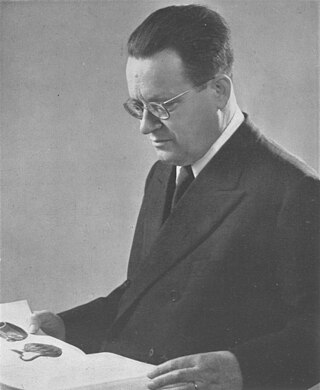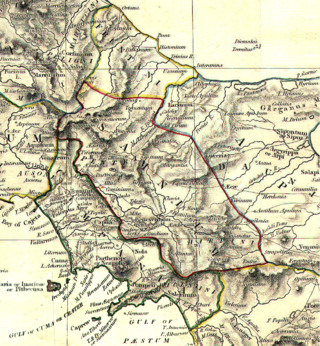Sources
- Giacomo Devoto, Preistoria e storia delle regioni d'Italia, 1a ed., Florence, Sansoni Università, 1974. P. 123.
- Giacomo Devoto, Gli antichi Italici, 2a ed., Florence, Vallecchi, 1951. P. 137.
The Opici were an ancient italic people of the Latino-Faliscan group who lived in the region of Campania. They settled in the area in the late Bronze Age but their territory was later conquered during the Iron Age by the Osci, another Italic people but of the Osco-Umbrian group.

The Italic languages form a branch of the Indo-European language family, whose earliest known members were spoken on the Italian Peninsula in the first millennium BC. The most important of the ancient languages was Latin, the official language of ancient Rome, which conquered the other Italic peoples before the common era. The other Italic languages became extinct in the first centuries AD as their speakers were assimilated into the Roman Empire and shifted to some form of Latin. Between the third and eighth centuries AD, Vulgar Latin diversified into the Romance languages, which are the only Italic languages natively spoken today, while Literary Latin also survived.

The province of Pesaro and Urbino is a province in the Marche region of Italy. Its capital is the city of Pesaro. It also borders the state of San Marino. The province is surrounded by San Marino and Emilia Romagna in the north, Umbria and Tuscany in the west, Ancona in the south and the Adriatic Sea on the east. The province has an enclave of the Umbrian commune of Citta' di Castello named Monte Ruperto. The province is also known as "Riviera of Hills". It is mostly covered by hills and is popular for its beaches.

The Osco-Umbrian, Sabellic or Sabellian languages are an extinct group of Italic languages, the Indo-European languages that were spoken in Central and Southern Italy by the Osco-Umbrians before being replaced by Latin, as the power of Ancient Rome expanded. Their written attestations developed from the middle of the 1st millennium BC to the early centuries of the 1st millennium AD. The languages are known almost exclusively from inscriptions, principally of Oscan and Umbrian, but there are also some Osco-Umbrian loanwords in Latin. Besides the two major branches of Oscan and Umbrian, South Picene may represent a third branch of Sabellic. The whole linguistic Sabellic area, however, might be considered a dialect continuum. Paucity of evidence from most of the "minor dialects" contributes to the difficulty of making these determinations.

The Latino-Faliscan or Latinian languages form a group of the Italic languages within the Indo-European family. They were spoken by the Latino-Faliscan people of Italy who lived there from the early 1st millennium BCE.

The Italic peoples were an ethnolinguistic group identified by their use of Italic languages, a branch of the Indo-European language family.
Sabellians is a collective ethnonym for a group of Italic peoples or tribes inhabiting central and southern Italy at the time of the rise of Rome. The name was first applied by Niebuhr and encompassed the Sabines, Marsi, Marrucini and Vestini. Pliny in one passage says the Samnites were also called Sabelli, and this is confirmed by Strabo. The term Sabellus is found also in Livy and other Latin writers, as an adjective form for Samnite, though never for the name of the nation; but it is frequently also used, especially by the poets, simply as an equivalent for the adjective Sabine.
The Carni were a tribe of the Eastern Alps in classical antiquity of Celtic language and culture, settling in the mountains separating Noricum and Venetia. They probably gave their name to Carso, Carnia, Carinthia, and Carniola.

The Picentes or Piceni or Picentini were an ancient Italic people who lived from the 9th to the 3rd century BC in the area between the Foglia and Aterno rivers, bordered to the west by the Apennines and to the east by the Adriatic coast. Their territory, known as Picenum, therefore included all of today's Marche and the northern part of Abruzzo.

Bruno Migliorini was an Italian linguist and philologist. He was the author of one of the first scientific histories of Italian language and was president of the Accademia della Crusca.

The Castellieri culture developed in Istria during the Early and Middle Bronze Age, and later expanded into Friuli, Dalmatia and the neighbouring areas. It lasted for more than a millennium, from the 18th century BC until the Roman conquest in the 3rd century BC. It takes its name from the fortified settlements, Castellieri, which characterized the culture. The term was coined by Carlo Marchesetti.

Giacomo Devoto was an Italian historical linguist and one of the greatest exponents of the twentieth century of the discipline. He was born in Genoa and died in Florence.

The Sidicini were one of the Italic peoples of ancient Italy. Their territory extended northward from their capital, Teanum Sidicinum, along the valley of the Liri river up to Fregellae, covering around 3,000 square kilometres in total. They were neighbors of the Samnites and Campanians, and allies of the Ausones and Aurunci. Their language was a part of the Osco-Umbrian linguistic family.
The Morgetes were an ancient Lucanian tribe, of Pelasgian descent, who occupied the region of southern Italy from Calabria to Sicily.
Luisa Banti was an Italian archaeologist, art historian, and educator specializing in the Etruscan and Minoan civilizations. Her best known work is Il mondo degli Etruschi. First published in 1960 and translated into several languages, it influenced scholarly opinion for many years and became a classic text.
Le Monnier was an Italian publishing house. It was purchased by Mondadori in 1999.
Gian Carlo Oli was an Italian lexicographer.

Istituto Nazionale di Studi Etruschi ed Italici is a cultural institution based in Florence, Tuscany, Italy. It was founded in 1925 with the aim of promoting and enhancing in Italy and worldwide studies on the Etruscan civilization and other peoples of ancient Italy.

Siculian is an extinct Indo-European language spoken in central and eastern Sicily by the Sicels. It is attested in less than thirty inscriptions from the late 6th century to 4th century BCE, and in around twenty-five glosses from ancient writers.